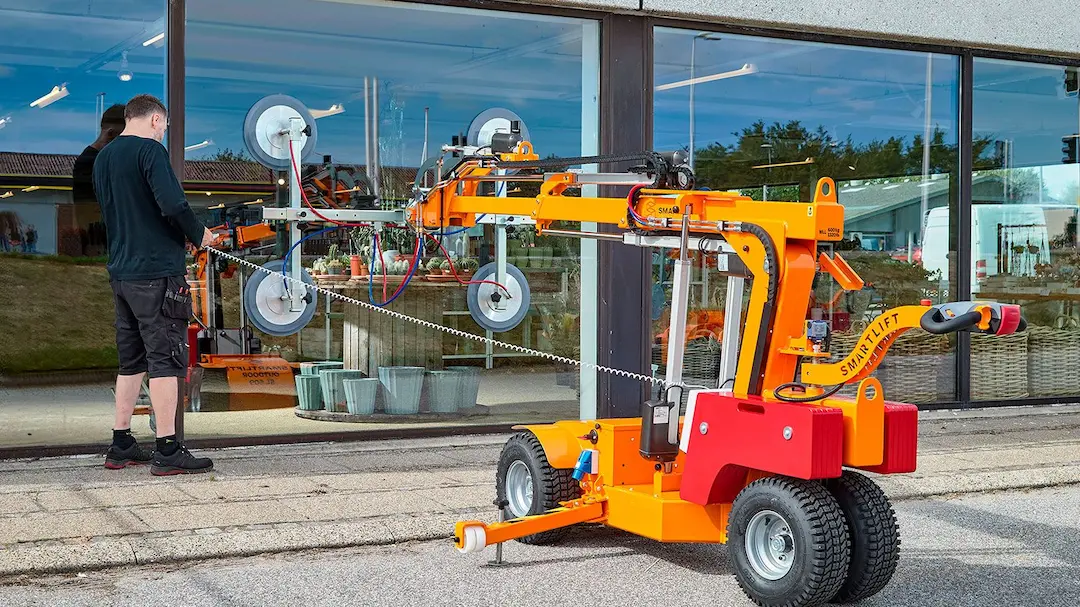Glass – a beautiful and versatile building material – can also pose a significant risk to worker safety. Working with glass demands attention to correct handling techniques and the appropriate equipment because of its inherent weight, fragility, and propensity for sharp cuts. Thankfully, technological developments have led to creative solutions, two of which are essential in reducing workplace injuries: glass lifters and vacuum lifters. In this blog, we examine the importance of these gadgets and how they reduce hazards, boost productivity, and create a safer workplace.
The Dangers of Manual Glass Handling
Let’s look at the possible risks of handling glass by hand before delving into the advantages of glass lifters:
Muscle Sprains and Strains: Glass panels, particularly the larger ones, can be heavy. Strains, sprains, and even rips in the back, shoulders, and arms muscles are common side effects of manually lifting and moving them.
Cuts and Lacerations: Severe cuts and lacerations can arise from even slight unintentional contact with glass. Workers must exercise considerable caution when transporting and installing these items because of the constant threat posed by their sharp edges.
Crushing Injuries: Large glass panels can topple or shift unexpectedly, causing crushing injuries to workers below. This risk is exceptionally high during installation processes at construction sites.
Repetitive Strain Injuries (RSIs): Jobs involving frequent glass handling involve repetitive motions. This can lead to RSIs, causing pain, discomfort, and long-term health issues.
In addition to affecting employee well-being, these hazards can result in decreased productivity, higher medical expenses, and possible legal ramifications for companies.
Glass Lifters For Enhanced Safety
Glass lifters provide a strong answer to these problems. They make the workplace safer in the following ways:
Reduced Physical Strain
Glass lifters indeed relieve laborers of their burdens. Suction pads are utilized by vacuum lifters to firmly hold the glass, making lifting, moving, and arranging the object easier. This reduces the possibility of injury and strained muscles.
Enhanced Control and Stability
Regarding control, glass lifters offer far more than manual handling. Because of the suction pads’ firm hold, there is less chance that the glass will slide and fall, which lowers the possibility of accidents resulting in injury.
Improved Worker Positioning
With revolving heads and movable arms, many glass lifters enable employees to position the panels precisely without awkwardly bending, reaching, or twisting. This lowers the risk of back injuries and encourages good posture.
Increased Worker Confidence
Glass lifters assure employees of their ability to handle glass safely and effectively by removing the uncertainty and physical strain of manual lifting.
Types of Glass Lifters: Choosing the Right Tool for the Job
Glass lifters come in a variety of forms, each meeting a particular purpose:
Vacuum Lifters
These are the most popular kind, gripping the glass firmly with suction pads. They can handle anything from massive architectural panels to tiny window panes because they are available in various sizes and capacities.
Clamp Lifters
These lifters fasten the glass by its edges with clamps. They work best when it is impossible to create a vacuum seal, usually due to a lack of power or compressed air the vacuum lifters require
Overhead Lifters
During installation at high places, these crane-mounted lifters offer precise control over huge, heavy glass panels.
Glass Carts and Dollies
Though not precisely lifters, these customized carts and dollies make it easier to transfer glass panels safely on level surfaces, lowering the possibility of worker fatigue and unintentional tipping.
The Benefits of Glass Lifters
Using glass lifters has many advantages over just reducing injury rates. Here’s a more comprehensive look at the benefits:
Increased Productivity: Glass lifters make lifting, moving, and installing objects faster. Glass panels can be handled by workers more quickly and effectively, which improves project completion times.
Reduced Worker Fatigue: Glass lifters minimize physical strain, which helps employees use less energy during the workday. Increased concentration and continuous productivity result from this.
Improved Worker Morale: Employee happiness and well-being improve in a safe work environment. Knowing their safety is a top priority can significantly improve morale and foster a happier work environment.
Reduced Downtime: Worker absenteeism and project delays are frequent outcomes of workplace injuries. By reducing the chance of harm, glass lifters improve worker health and reduce wasted time.
Lower Insurance Costs: Employers can expect a reduction in workers’ compensation insurance premiums if they maintain a steady safety record.
Choosing and Maintaining Glass Lifters
Selecting the suitable glass lifter requires careful consideration of several factors:
- The size and weight of the glass panels you typically handle.
- The lifting height and reach required.
- The type of environment where the lifter will be used (indoor vs. outdoor).
- Your budget and desired features.
After selecting the suitable glass lifter, regular upkeep is essential to guarantee its safety and best performance.
A Safe and Efficient Future with Glass Lifters
Glass lifters are an investment in the staff and the general effectiveness of your glass handling operations, not merely a piece of safety gear. By reducing potential harm, they create a more secure and healthful workplace. They also help to decrease downtime, boost employee morale, and promote production.
If you work with glass, consider incorporating glass lifters from Tait Sales & Consulting into your operations. It’s a decision that will benefit your workers, your business, and, ultimately, the quality of your work.

